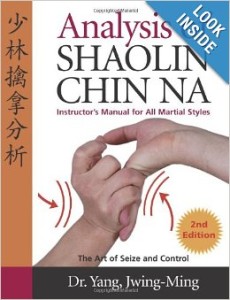 Analysis of Shaolin Chin Na: Instructor’s Manual for All Martial Styles by Dr. Yang, Jwing-Ming is a text book full of Shaolin Chin Na principles and techniques. For those not familiar with Chin Na, it is one of the four major fighting categories in Chinese martial arts. The four categories are kicking, striking, wrestling, and seize-controlling. Chin Na can be called the art of seize and control, and it consists of various joint locking techniques, as well as different grabbing, pressing, and striking.
Analysis of Shaolin Chin Na: Instructor’s Manual for All Martial Styles by Dr. Yang, Jwing-Ming is a text book full of Shaolin Chin Na principles and techniques. For those not familiar with Chin Na, it is one of the four major fighting categories in Chinese martial arts. The four categories are kicking, striking, wrestling, and seize-controlling. Chin Na can be called the art of seize and control, and it consists of various joint locking techniques, as well as different grabbing, pressing, and striking.
Just like joint locks are only a portion of the Hapkido curriculum I teach, Chin Na is only a portion of Chinese arts. With that said, the concepts and techniques can be learned and incorporated into other styles, especially those that are already familiar with locking techniques such as practitioners of Hapkido, Aikido, Jujitsu, and so forth. Therefore, this book can benefit many martial artists, not just those who study Chinese arts. If your style does not include locking type techniques, Chin Na resources, including this book, can assist you in rounding out your program.
After a short Foreword and two short Prefaces (original and new one for second edition), there is a general introduction to Chin Na and the basic principles. Next comes a chapter that focuses on fundamental training. A variety of exercises are illustrated and explained that will enable a practitioner to better perform Chin Na techniques.
The next few chapters are divided by the type of Chin Na explained in them. They consist of Finger Chin Na; Wrist Chin Na; Elbow Chin Na; Shoulder, Neck and Waist Chin Na, Leg Chin Na; Muscle Grabbing Chin Na; Cavity Press; and then a short chapter on using Chin Na in a fight, and another on the treatment of injuries. The book then concludes with a two-paragraph conclusion and several appendixes.
There are numerous techniques in this book (The back cover says over 150), and each one has a description of how to do the technique, with accompanying photographs, the principle behind the technique pointed out, and a description with photos of an escape and counter to the technique. I especially liked that these escapes and counters were included. I felt these added much value to the collection of information, especially as an instructor resource. The pictures are black and white, and sometimes a little difficult to fully discern what is being done. If you are apt at joint locking techniques, you can most likely figure it out. However, if you are a novice, you might have a little trouble with some of them. To remedy this, you could pick up Dr. Yang’s DVDs to see the techniques performed. In fact, I’d encourage anyone to complete their Chin Na resource library by including both the books and DVDs Dr. Yang has put out. Using them together make for a much better learning experience.
The chapter on using Chin Na in a fight is pretty short. There are two pages of good concepts, and then a small sampling of concepts and techniques illustrated with photographs. Dr. Yang admits this is just a tiny sample, but points out that he included more in his book “Comprehensive Applications of Shaolin Chin Na.” I have not read that book yet, but it is on my list. Like the applications chapter, the treatment of injuries chapter is also short. You won’t be a competent healer from this chapter, but it gives some general information and hopefully peaks your interest to further your study in the healing arts as well as the fighting arts. They go hand in hand.
Overall, this is an exceptional manual to help a person learn Chin Na, and I recommend it highly, as I do all of Dr. Yang’s cannon of Chin Na resources.


Be the first to comment on "Analysis of Shaolin Chin Na – A Review"